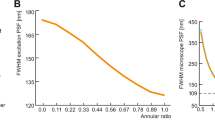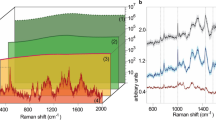Abstract
This protocol describes a method combining phase-contrast and fluorescence microscopy, Raman spectroscopy and optical tweezers to characterize the germination of single bacterial spores. The characterization consists of the following steps: (i) loading heat-activated dormant spores into a temperature-controlled microscope sample holder containing a germinant solution plus a nucleic acid stain; (ii) capturing a single spore with optical tweezers; (iii) simultaneously measuring phase-contrast images, Raman spectra and fluorescence images of the optically captured spore at 2- to 10-s intervals; and (iv) analyzing the acquired data for the loss of spore refractility, changes in spore-specific molecules (in particular, dipicolinic acid) and uptake of the nucleic acid stain. This information leads to precise correlations between various germination events, and takes 1–2 h to complete. The method can also be adapted to use multi-trap Raman spectroscopy or phase-contrast microscopy of spores adhered on a cover slip to simultaneously obtain germination parameters for multiple individual spores.
This is a preview of subscription content, access via your institution
Access options
Subscribe to this journal
Receive 12 print issues and online access
$259.00 per year
only $21.58 per issue
Buy this article
- Purchase on Springer Link
- Instant access to full article PDF
Prices may be subject to local taxes which are calculated during checkout






Similar content being viewed by others
References
Setlow, P. & Johnson, E.A. Spores and their significance. In Food Microbiology: Fundamentals And Frontiers 3rd edn. (eds. Doyle, M.P., Beuchat, L.R. & Montville, T.J.) 35–67, (ASM Press, 2007).
Piggot, P.J. & Hilbert, D.W. Sporulation of Bacillus subtilis. Curr. Opin. Microbiol. 7, 579–586 (2004).
Nicholson, W.L., Munakata, N., Horneck, G., Melosh, H.J. & Setlow, P. Resistance of Bacillus endospores to extreme terrestrial and extraterrestrial environments. Microbiol. Mol. Biol. Rev. 64, 548–572 (2000).
Setlow, P. Spores of Bacillus subtilis: their resistance to radiation, heat and chemicals. J. Appl. Microbiol. 101, 514–525 (2006).
Setlow, P. Spore germination. Curr. Opin. Microbiol. 6, 550–556 (2003).
Moir, A. How do spores germinate? J. Appl. Microbiol. 101, 526–530 (2006).
Gerhardt, P. & Marquis, R.E. Spore thermoresistance mechanisms. In Regulation of Prokaryotic Development (eds. Smith, I., Slepecky, R.A. & Setlow, P.) 43–63 (American Society for Microbiology, 1989).
Setlow, B., Wahome, P.G. & Setlow, P. Release of small molecules during germination of spores of Bacillus species. J. Bacteriol. 190, 4759–4763 (2008).
Scott, I.R. & Ellar, D.J. Study of calcium dipicolinate release during bacterial spore germination by using a new, sensitive assay for dipicolinate. J. Bacteriol. 135, 133–137 (1978).
Cheung, H.Y., Cui, J. & Sun, S.Q. Real time monitoring of Bacillus subtilis endospore components by attenuated total reflection Fourier transform infrared spectroscopy during germination. Microbiology 145, 1043–1048 (1999).
Hindle, A.A. & Hall, E.A.H. Dipicolinic acid (DPA) assay revisited and appraised for spore detection. Analyst 124, 1599–1604 (1999).
Zaman, M.S. et al. Imaging and analysis of Bacillus anthracis spore germination. Microsci. Res. Tech. 66, 307–311 (2005).
Plomp, M., Leighton, T.J., Wheeler, K.E., Hill, H.D. & Malkin, A.J. In vitro high-resolution structural dynamics of single germinating bacterial spores. Proc. Natl Acad. Sci. USA 104, 9644–9649 (2007).
Zernike, F. How I discovered phase contrast. Science 121, 345–349 (1955).
Hashimoto, T., Frieben, W.R. & Conti, S.F. Germination of single bacterial spores. J. Bacteriol. 98, 1011–1020 (1969).
Gould, G.W. Germination. In The Bacterial Spore (eds. Gould G.W. & Hurst A.) 397–444 (Academic Press, 1969).
Ragkousi, K., Cowan, A.E., Ross, M.A. & Setlow, P. Analysis of nucleoid morphology during germination and outgrowth of spores of Bacillus species. J. Bacteriol. 182, 5556–5562 (2000).
Laflamme, C., Lavigne S., HoJ. & Duchaine, C. Assessment of bacterial endospore viability with fluorescent dyes. J. Appl. Microbiol. 96, 684–692 (2004).
Black, E.P et al. Factors influencing germination of Bacillus subtilis spores via activation of nutrient receptors by high pressure. Appl. Environ. Microbiol. 71, 5879–5887 (2005).
Welkos, S.L., Cote, C.K., Rea, K.M. & Gibbs, P.H. A microtiter fluorometric assay to detect the germination of Bacillus anthracis spores and the germination inhibitory effects of antibodies. J. Microbiol. Methods 56, 253–265 (2004).
Mathys, A., Chapman, B., Bull, M., Heinz, V. & Knorr, D. Flow cytometric assessment of Bacillus spore response to high pressure and heat. Innovat. Food Sci. Emerg. Tech. 8, 519–527 (2007).
Evanoff, D.D., Heckel, J., Caldwell, T.P., Christensen, K.A. & Chumanov, G. Monitoring DPA release from a single germinating Bacillus subtilis endospore via surface-enhanced Raman scattering microscopy. J. Am. Chem. Soc. 128, 12618–12619 (2006).
Daniels, J.K., Caldwell, T.P., Christensen, K.A. & Chumanov, G. Monitoring the kinetics of Bacillus subtilis endospore germination via surface-enhanced Raman scattering spectroscopy. Anal. Chem. 78, 1724–1729 (2006).
Ashkin, A., Dziedzic, J.M., Bjorkholm, J.E. & Chu, S. Observation of a single-beam gradient force optical trap for dielectric particles. Opt. Lett. 11, 288–290 (1986).
Ashkin, A. & Dziedzic, J.M. Optical trapping and manipulation of viruses and bacteria. Science 235, 1517–1520 (1987).
MacDonald, M.P., Spalding, G.C. & Dholakia, K. Microfluidic sorting in an optical lattice. Nature 426, 421–424 (2003).
Min, T.L. et al. High-resolution, long-term characterization of bacterial motility using optical tweezers. Nat. Methods 6, 831–835 (2009).
Mehta, A.D., Reif, M., Spudich, J.A., Smith, D.A. & Simmons, R.M. Single-molecule biomechanics with optical methods. Science 283, 1689–1695 (1999).
Xie, C.A., Dinno, M.A. & Li, Y.Q. Near-infrared Raman spectroscopy of single optically trapped biological cells. Opt. Lett. 27, 249–251 (2002).
Chan, J.W. et al. Reagentless identification of single bacterial spores in aqueous solution by confocal laser tweezers Raman spectroscopy. Anal. Chem. 76, 599–603 (2004).
Huang, S.S. et al. Levels of Ca2+-dipicolinic acid in individual Bacillus spores determined using microfluidic Raman tweezers. J. Bacteriol. 189, 4681–4687 (2007).
Chen, D., Huang, S.S. & Li, Y.Q. Real-time detection of kinetic germination and heterogeneity of single Bacillus spores by laser tweezers Raman spectroscopy. Anal. Chem. 78, 2936–6941 (2006).
Peng, L., Chen, D., Setlow, P. & Li, Y.Q. Elastic and inelastic light scattering from single bacterial spores in an optical trap allows the monitoring of spore germination dynamics. Anal. Chem. 81, 4035–4042 (2009).
Kong, L., Zhang, P., Setlow, P. & Li, Y.Q. Characterization of bacterial spore germination using integrated phase contrast microscopy, Raman spectroscopy and optical tweezers. Anal. Chem. 82, 3840–3847 (2010).
Coote, P.J. et al. The use of confocal scanning laser microscopy (CSLM) to study the germination of individual spores of Bacillus cereus. J. Microbiol. Meth. 21, 193–208 (1995).
Zhang, P., Kong, L., Wang, G., Setlow, P. & Li, Y.Q. Combination of Raman tweezers and quantitative differential interference contrast microscopy for measurement of dynamics and heterogeneity during the germination of individual bacterial spores. J. Biomed. Opt. 15, 056010 (2010).
Kong, L., Zhang, P., Yu, J., Setlow, P. & Li, Y.Q. Monitoring the kinetics of uptake of a nucleic acid dye during the germination of single spores of Bacillus species. Anal. Chem. 82, 8717–8724 (2010).
Zhang, P., Kong, L., Setlow, P. & Li, Y.Q. Multiple-trap laser tweezers Raman spectroscopy for simultaneous monitoring of the biological dynamics of multiple individual cells. Opt. Lett. 35, 3321–3323 (2010).
Thanbichler, M. & Shapiro, L. Getting organized—how bacterial cells move proteins and DNA. Nat. Rev. Microbiol. 6, 28–40 (2008).
Clements, M.O. & Moir, A. Role of gerI operon of Bacillus cereus 569 in the response of spores to germinants. J. Bacteriol. 180, 6729–6735 (1998).
Zhang, P. et al. Factors affecting the variability in time between addition of nutrient germinants and rapid dipicolinic acid release during germination of spores of Bacillus species. J. Bacteriol. 192, 3608–3619 (2010).
Acknowledgements
This work was supported by a grant from the Army Research Office (Y.-q.L. and P.S.) and by a Multidisciplinary University Research Initiative award from the United States Department of Defense (P.S. and Y.-q.L.).
Author information
Authors and Affiliations
Contributions
L.K. and Y.-q.L. designed the experimental setup, performed the research, analyzed data and wrote the manuscript. P.Z., G.W. and J.Y. performed the experiments and analyzed data. P.S. provided spore samples, supervised the microbiological work and revised the manuscript.
Corresponding author
Ethics declarations
Competing interests
The authors declare no competing financial interests.
Supplementary information
Supplementary Methods
Code for the computer programs used in this protocol. QSI CCD control_VB code. DAQ control_Matlab code. (RTF 320 kb)
Rights and permissions
About this article
Cite this article
Kong, L., Zhang, P., Wang, G. et al. Characterization of bacterial spore germination using phase-contrast and fluorescence microscopy, Raman spectroscopy and optical tweezers. Nat Protoc 6, 625–639 (2011). https://doi.org/10.1038/nprot.2011.307
Published:
Issue Date:
DOI: https://doi.org/10.1038/nprot.2011.307
This article is cited by
-
Hypervirulent R20291 Clostridioides difficile spores show disinfection resilience to sodium hypochlorite despite structural changes
BMC Microbiology (2023)
-
Label-free mid-infrared photothermal live-cell imaging beyond video rate
Light: Science & Applications (2023)
-
Construction of Graphene@Ag-MLF composite structure SERS platform and its differentiating performance for different foodborne bacterial spores
Microchimica Acta (2023)
-
Optical tweezers-controlled hotspot for sensitive and reproducible surface-enhanced Raman spectroscopy characterization of native protein structures
Nature Communications (2021)
-
Standardization of complex biologically derived spectrochemical datasets
Nature Protocols (2019)
Comments
By submitting a comment you agree to abide by our Terms and Community Guidelines. If you find something abusive or that does not comply with our terms or guidelines please flag it as inappropriate.



